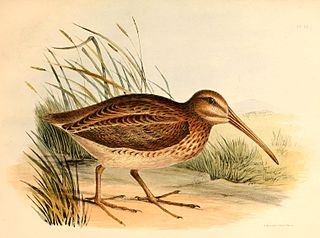
A snipe is any of about 26 wading bird species in three genera in the family Scolopacidae. They are characterized by a very long, slender bill, eyes placed high on the head, and cryptic/camouflaging plumage. The Gallinago snipes have a nearly worldwide distribution, the Lymnocryptes snipe is restricted to Asia and Europe and the Coenocorypha snipes are found only in the outlying islands of New Zealand. The four species of painted snipe are not closely related to the typical snipes, and are placed in their own family, the Rostratulidae.

Gallinago is a genus of birds in the wader family Scolopacidae, containing 17 species.
Viti or Víti may refer to:

The Subantarctic snipe is a species of snipe endemic to New Zealand's subantarctic islands. The Maori call it "Tutukiwi". The nominate race C. a. aucklandica is found on the Auckland Islands. Other subspecies include C. a. meinertzhagenae from the Antipodes Islands, and C. a. perseverance from Campbell Island. The former subspecies from the Snares Islands has been separated as a full species, the Snares snipe, as have the extinct South Island and North Island snipes.

The austral snipes, also known as the New Zealand snipes or tutukiwi, are a genus, Coenocorypha, of tiny birds in the sandpiper family, which are now only found on New Zealand's outlying islands. There are currently three living species and six known extinct species, with the Subantarctic snipe having three subspecies, including the Campbell Island snipe discovered as recently as 1997. The genus was once distributed from Fiji, New Caledonia and Norfolk Island, across New Zealand and southwards into New Zealand's subantarctic islands, but predation by introduced species, especially rats, has drastically reduced their range.

The Chatham snipe or Chatham Island snipe is a species of wader in the family Scolopacidae. It is endemic to the Chatham Islands of New Zealand, and is only found on a few islands in the south of the Chatham Islands group.

Hakawai, also Hokioi in the North Island, was to the New Zealand Māori people, a mythological bird that was sometimes heard but not usually seen. It is now associated with the nocturnal aerial displays made by Coenocorypha snipe.
Forbes's snipe was a species of New Zealand snipe endemic to the Chatham Islands. It was the larger of two species found there, the smaller being the surviving Chatham snipe. It was never seen alive by scientists and is known only from fossil material collected on the islands. Why it became extinct while its smaller relative survived is a mystery, as is the exact timing of its extinction, although it may have survived, unnoticed, until the 15th century.
Trevor Henry Worthy is an Australia-based paleozoologist from New Zealand, known for his research on moa and other extinct vertebrates.

The Campbell snipe, also known as the Campbell Island snipe, is a rare subspecies of the Subantarctic snipe, endemic to Campbell Island, a subantarctic island south of New Zealand in the Southern Ocean. It was not formally described until January 2010. The subspecific name alludes to the name of the sealing brig Perseverance, captained by Frederick Hasselborough, that discovered Campbell Island in 1810, and which probably inadvertently introduced rats to the island when it was wrecked there in 1828.

The Snares snipe, also known as the Snares Island snipe, or tutukiwi in Māori, is a species of bird in the sandpiper family, Scolopacidae.
The South Island snipe, also known as the Stewart Island snipe or tutukiwi in Māori, is an extinct species of bird in the sandpiper family Scolopacidae that was endemic to New Zealand.

The North Island snipe, also known as the little barrier snipe or tutukiwi, is an extinct species of bird in the sandpiper family, Scolopacidae, that was endemic to New Zealand.
The Antipodes snipe, also known as the Antipodes Island snipe, is an isolated subspecies of the Subantarctic snipe that is endemic to the Antipodes Islands, a subantarctic island group south of New Zealand in the Southern Ocean.

The Auckland snipe, also known as the Auckland Island snipe, is a small bird in the sandpiper family. It is the isolated nominate subspecies of the subantarctic snipe that is endemic to the Auckland Islands, a subantarctic island group south of New Zealand in the Southern Ocean.
The New Caledonian snipe is an extinct species of austral snipe, described from late Holocene cave deposits on the French island of New Caledonia in the western Pacific Ocean. The specific epithet is a latinisation of the name of its island home.
The year 2013 in birding and ornithology.







